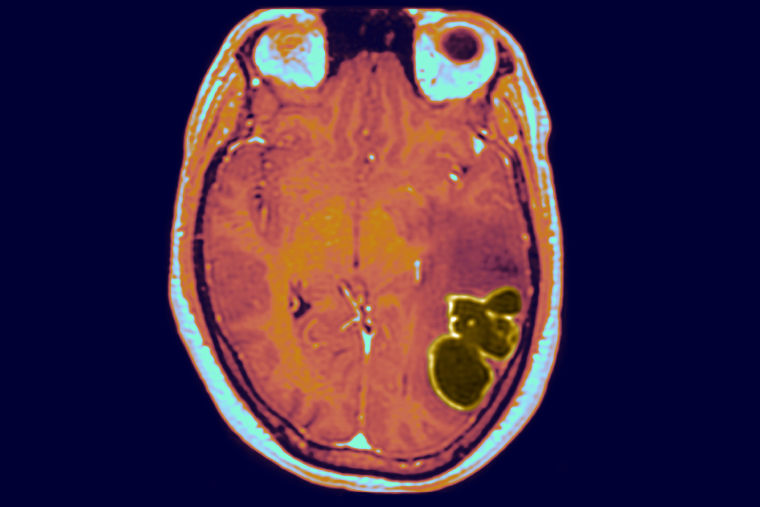After seeing an unusually high number of children with life-threatening brain infections last year, doctors are calling attention to the puzzling trend.
In a presentation Thursday, researchers at the Southern Nevada Health District said there were 18 cases of pediatric brain abscesses — pus-filled pockets in the brain — in Clark County in 2022. By comparison, there was an average of five cases annually from 2015 to 2021.
The findings were released at the Centers for Disease Control and Prevention’s annual Epidemic Intelligence Service Conference and first reported by CNN.
Dr. Taryn Bragg, an associate professor at the University of Utah who treated the Nevada cases, said that last spring, “every single call I was getting from the ER was a kid coming in with a brain abscess."
But cases in Nevada have declined considerably in recent months, she said. Bragg said she treated two patients for brain abscesses at the start of the year and hasn’t seen any since then.
Brain abscesses are rare and generally form when fungi or bacteria enter brain tissue because of injury or infection. The body uses healthy tissue to form an abscess to stop the infection from spreading. If left untreated, the condition can cause permanent brain damage or death.
The reasons for the recent spike in brain abscesses among children are unknown.
When the CDC investigated the trend last year, its report identified a national increase in pediatric brain abscesses in summer 2021, followed by a peak in March 2022.
However, the report also said the increase was “consistent with historical seasonal fluctuations observed since 2016” and showed that the rate of abscesses declined to baseline levels from March to May 2022.
Bragg noted, however, that the CDC investigation ended as cases in Nevada were continuing to spike.
Dr. Shaun Rodgers, a pediatric neurosurgeon at Cohen Children’s Medical Center — part of Northwell Health in New York — said his hospital is still seeing an above-average number of brain abscesses, a trend that started around the end of 2022.
“It’s not just us. It’s hospitals all over the country,” Rodgers said. “When we’re talking to colleagues, it seems like everyone is feeling that we’ve definitely had an uptick in these types of infections.”
He noted, though, that because brain abscesses are rare, this year’s total is still in the single digits at his hospital.
Dr. Samir Shah, vice chair of clinical affairs and education at Cincinnati Children’s Hospital Medical Center, said brain abscesses occur in about one out of every eight million people, on average.
But even so, he added, "we always worry when we hear people say, ‘Hey, we’re seeing a little bit more of this.’ All of a sudden we’re on high guard because, if there is something going on, we absolutely want to know."
Shah, who co-authored the national CDC report, suggested that the trend could partly be due to the surge of respiratory viruses and bacterial infections — including group A strep — over the winter. Many experts think a lack of exposure to viruses and bacteria during the pandemic weakened people's ability to fight them off.
“As soon as we started to undo some of these [pandemic restrictions], you started to see the viruses come back, you saw more sinus infections, and then, not surprisingly, you ended up seeing more brain abscesses,” Shah said.
Respiratory viruses can lead to sinus infections, which can predispose kids to brain abscesses, Rodgers explained.
"It seems like we're having an uptick in sinus infections that have sort of gone undiagnosed for a while, and then they can actually go through the bone and get into the brain," he said.
Other researchers haven't ruled out the possibility that Covid itself may play a role. Another CDC report identified a roughly 100% increase in brain abscesses, on average, across eight pediatric hospitals during the first two years of the pandemic.
One hospital in particular — Helen DeVos Children’s Hospital in Grand Rapids, Michigan — saw a 236% increase in bacterial brain infections during that time.
“We were wondering if the virus itself was causing some sort of inflammatory process that was allowing these bacteria to invade," said Dr. Rosemary Olivero, the hospital’s division chief of medical subspecialties. "That has not been a question that we’ve been able to answer yet.”
But Olivero said brain abscesses at her hospital are now back to baseline levels — she estimated that the hospital has seen less than five cases so far this year.
Shah said Cincinnati Children’s has only seen a couple cases of brain abscesses this year. In general, he added, the symptoms to look out for include fever, headache and vomiting. Children experiencing the condition may also have seizures or stroke-like symptoms such as impaired motor skills or slurred speech.
Doctors treat the abscesses with antibiotics, and multiple surgeries are often required. Shah said a one- to two-week stay in the hospital is fairly typical, followed by two to four weeks of additional IV antibiotics at home.
Although doctors can voluntarily report brain abscess cases to public health departments, they are not required to do so. That makes the national picture unclear, so several doctors are calling for more surveillance.
"It would not surprise me, if you looked all across the country, that you started seeing more of these" cases, Shah said.

